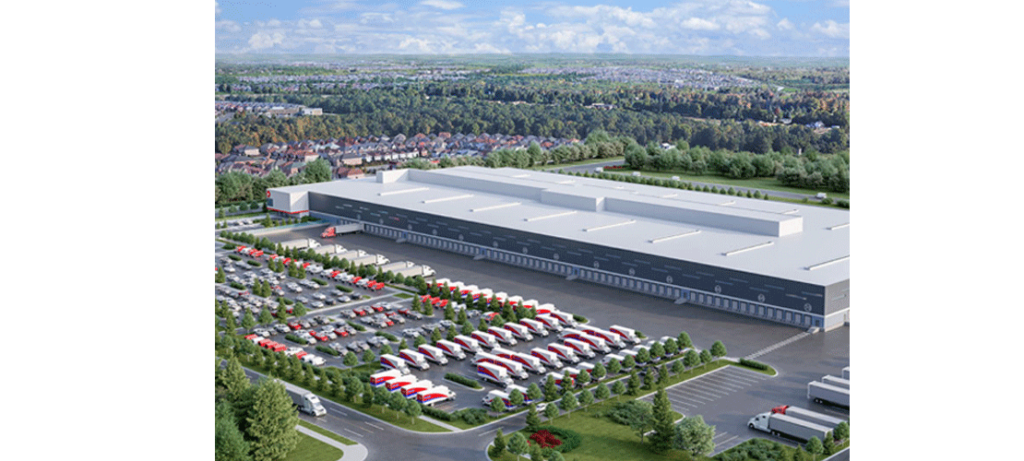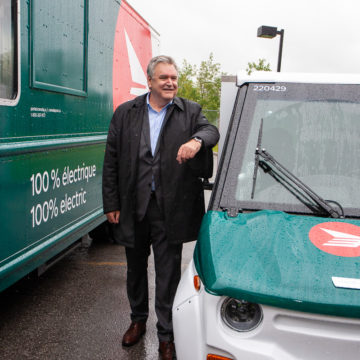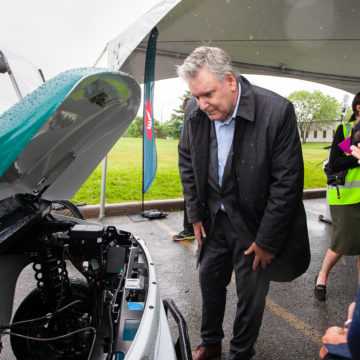How We’re Greening Canada Post for Future Generations
Canada Post President and CEO Doug Ettinger details the ambitious plan for a net-zero transformation that earned Canada Post Corporation a Clean16 Award.
Slashing emissions starts with detailed planning. Climate targets need to align with climate science and the art of the possible for your organization. For us, this planning was years in the making.
Our net zero climate planning started with our transformation planning. In 2020, we embarked on a transformation defined by our new purpose: A Stronger Canada – Delivered. This strategic and integrated plan, focused on the needs of our customers and the country we serve, invests $4 billion into the Corporation over five years. We’re doing everything we can to meet the evolving expectations of Canadians.
With approximately 68,000 employees and a presence in thousands of communities, we are a massive organization. Climate planning therefore confronted us with a massive challenge. How do we slash emissions from an organization that delivers to every Canadian address? That has the largest retail network in Canada, with close to 6,000 post offices? That has a real estate portfolio of about 3,000 properties? That has a fleet of approximately 14,000 vehicles? In 2021 our vehicles drove 104.1 million kilometres – that’s the equivalent of circling the globe more than 2,500 times.
While the scale of the challenge was intimidating, we knew we had to take it on. We needed a robust plan that would get us to net zero by 2050, in alignment with our federal partners. We had to make significant emission reductions while increasing our capacity to deliver for Canadians – reliably and on-time.
The 6th UN IPCC assessment report handed down an indictment on inaction and warned of the rapidly closing window that humanity had to shape a sustainable future. Like so many others at the time, we knew we needed to be more ambitious.
Doug Ettinger
Setting our targets
With support from the Board of Directors, step No. 1 was to develop a third party-verified carbon inventory. This vital data allowed us to identify our emission sources and where we could make the biggest impact. The carbon inventory paved the way to establishing emission reduction targets and helped us identify three areas for action: making our fleet low-emission, using renewable energy, and greening our real estate portfolio.
In 2021 the Science Based Targets initiative (SBTi), an organisation that independently assesses companies’ emission plans, approved our targets. Our plan was in motion. But then came the release of the sixth assessment report of the UN’s Intergovernmental Panel on Climate Change (IPCC). It was a wake-up call. The report handed down an indictment on inaction and warned of the rapidly closing window that humanity had to shape a sustainable future.
Like so many others at the time, we knew we needed to be more ambitious. Fortunately, government policies had shifted to encourage faster deployment of electric vehicles in Canada and around the world. This fomented our desire for more ambitious targets that, a mere 12 months earlier, seemed impossible.
In late 2021, the Canada Post Board approved an enhanced climate target, committing the Corporation to a 50 per cent reduction in Scope 1 and 2 emissions by 2030. This target, which has been submitted to the SBTi for approval, is built to meet its 1.5°C pathway – intended to limit global warming to 1.5°C above pre-industrial levels.
At the same time, we worked with consultants to map and forecast our footprint, factoring in anticipated changes to legislation, advances in technology and the evolution of our business. This detailed footprint provided the information we needed to create a precise climate plan that takes a building-by-building, vehicle-by-vehicle approach to our entire network.
Our goal is to get the top 67% of our suppliers to establish science-based targets by 2025.
Doug Ettinger
Electrifying our fleet
Earlier this year, in alignment with our climate target, we announced a commitment to transform our fleet of nearly 14,000 vehicles to electric. With Board approval of a $1-billion investment, we committed to reach a 50 per cent electric fleet by 2030 and 100 per cent by 2040.
We know there’s no silver bullet when it comes to our vehicles. It’s a process that will require trial and error as we test innovative vehicles in urban centres and other environments – to learn what meets our needs. We’ve already started this experimentation, working closely with our bargaining agents and partners.
We also recognize that the procurement of these vehicles at scale, with their supporting infrastructure, will be a challenge. It will require acceleration across our supply chain. It will mean building charging infrastructure at approximately 350 depots across the country, and ensuring that we’re powering our fleet with green grids wherever possible.
Greening our buildings
The greening of our real estate portfolio is a separate challenge in our plan – and a big one at that. For our existing buildings, the priority is retrofits and upgrades, with the goal of consuming as little energy as possible.
Recently, we started implementing pilot projects at 62 properties across the country. The data gathered from these pilots will help us measure the impacts of various greening initiatives – such as LED lighting retrofits, solar panels, electrification of our energy sources (e.g., heat pumps), system upgrades like automation, and sensor-controlled heating and cooling. We’re also undertaking building commissioning to determine how efficiently buildings are operating and where we can have the biggest impact.
Another significant challenge will be overhauling our existing electrical infrastructure. We’re looking at how to increase our power supply to be able to operate our buildings, run industrial equipment, and charge about 14,000 vehicles. Some of our buildings simply aren’t designed for these kinds of power loads.
A key element of our plan is that any new builds will meet the Zero Carbon Building standard of the Canada Green Building Council. Our finest example of that is a $470-million, state-of-the-art facility in the Greater Toronto Area, slated to open next year and which we’ve proudly named the Albert Jackson Processing Centre. This 585,000 square-foot plant is currently the largest industrial project in Canada built with the Zero Carbon Building Standard.
The Albert Jackson Processing Centre will be able to process more than one million packages a day at full capacity – and accomplish that as a net-zero facility. It’s built with solar panels, a high-performing envelope, building system automation, efficient HVAC, and sensor-controlled light fixtures, among other innovations. Longer term, we’ll be building other net zero plants, but for the moment we can’t say how excited we are to get Albert Jackson online and moving Canadians’ parcels.

Looking forward
We recognize there will be many challenges ahead. Biggest among them may be addressing our Scope 3, or indirect emissions. We are currently working with our subsidiaries (Purolator and SCI) as well as our suppliers to help them set their own science-based targets. Our goal is to get the top 67 per cent of our suppliers (by spending) to establish science-based targets by 2025.
We’ll need to work in partnership with our suppliers to reduce emissions across our supply chain. It will require evolution on many fronts: changes in legislation, alternative fuel policies, investment in next-generation technologies by all players, and various partnerships to accelerate change.
There is much more work ahead and we recognize that we need to move faster. As the IPCC’s sixth assessment report illustrated, there is no time to waste. It’s time for all of us to mobilize and accelerate action – for ourselves, our families and future generations. We owe this to Canadians.




















